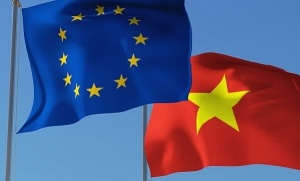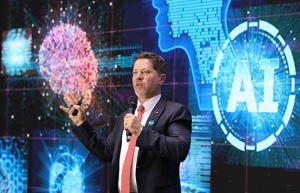Unprecedented levels of net-zero investment opportunities in Vietnam
 |
The report, titled "Net-Zero Transition: Opportunities for Vietnam", reveals that Vietnam can still fulfill its goal of reaching net-zero emissions by 2050 and help limit global warming to well below 2°C. But doing so rests on a rapid scale-up of clean power, electric vehicles, and, to a lesser extent, carbon capture and storage technology.
The report presents two updated climate scenarios: a Net Zero Scenario that maps a path to net-zero emissions globally by 2050, aligned with the Paris Agreement, and a base-case Economic Transition Scenario driven by the cost-competitiveness of technologies. This modelling is designed to inform public policymaking, countries’ climate ambitions and the low-carbon transition strategies of corporations and financial institutions.
Under BNEF’s Net Zero Scenario, swift deployment of renewables, led by solar and wind, would enable Vietnam’s power sector to peak its emissions in 2026. For the transport sector, emissions hit their apex in 2029 and fall quickly thereafter, largely driven by the electrification of road vehicles. Industrial emissions are the last to peak in 2033, with a sharp drop across the late 2030s due to the adoption of carbon capture and storage technology and hydrogen to decarbonise heavy industries.
In this net-zero pathway, three drivers account for 78 per cent of Vietnam’s emissions abatement through to mid-century: clean power, carbon capture, and energy efficiency. The remaining reductions come from electrification, bioenergy, and hydrogen.
Compared to Vietnam’s eighth national power development plan approved in May 2023 (known as PDP8), BNEF’s scenarios envisage a larger buildout of solar and batteries for energy storage due to their economic competitiveness, as well as lower deployment of gas-fired power generation.
In BNEF’s economics-led scenario, installed solar capacity will be 25GW higher than PDP7 by 2030 and 96GW higher by 2050. Under the Net Zero Scenario, solar capacity will reach 512GW by mid-century, almost three times the target proposed by PDP8.
Reaching net-zero emissions by mid-century will require a rapid ramp-up of investment in both energy demand and supply. Totalling $2.4 trillion across 2024 to 2050 in the Net Zero Scenario, this includes $1 trillion of demand-side investment – just 14 per cent higher than in an economics-led transition thanks to the falling costs of EVs.
However, funding requirements for the supply side are more than twice as high under a net-zero pathway compared to the Economic Transition Scenario, due to increased electricity demand and the need for carbon capture. Investment in carbon capture and storage would reach $183 billion under the Net Zero Scenario, whereas it would be zero under the economics-led transition.
“Vietnam has effectively positioned itself as the manufacturing base for many multinational companies with clean power procurement goals,” said Hanh Phan, an associate in BNEF’s Southeast Asia team and lead author of the report. “The country can utilise these firms’ growing demand for green electricity to accelerate the deployment of renewables this decade, while also laying the regulatory groundwork for decarbonisation of hard-to-abate sectors.”
 | EU releases $23 million fund for clean energy in Vietnam The European Union has released $23.6 million of budget support to the Vietnamese government in the framework of the EU - Viet Nam Sustainable Energy Transition Programme (SETP). |
 | A tale of two trends: Digital transformation and net-zero transition The world is changing faster than we imagine, and the pace of change is only going to accelerate. Tim Evans, CEO of HSBC Vietnam, explains why we must adapt and find ways to navigate the challenges, as they will ultimately also present opportunities for those prepared for them. |
 | The path to carbon neutrality: what matters beyond ESG investments? The 2021 movie Don’t Look Up starts with a shocking premise: a comet estimated to be 5-10km in diameter is hurtling towards Earth. There are only six months left before impact, yet despite the scientific certainty, the political, economic, and media leadership in the United States is consumed by their own interests. |
What the stars mean:
★ Poor ★ ★ Promising ★★★ Good ★★★★ Very good ★★★★★ Exceptional
 Tag:
Tag:
Related Contents
Latest News
More News
- Schaeffler reports strong early output from Dong Nai solar project (December 12, 2025 | 15:16)
- Forestry conference highlights biodiversity and sustainability goals (December 09, 2025 | 13:35)
- Home Credit honoured among top 10 sustainable companies in trade and services (December 09, 2025 | 12:18)
- SCG and seven member companies honoured in Top 100 Sustainable Businesses 2025 (December 08, 2025 | 09:00)
- Nestlé Vietnam pioneers sustainable development and promotes business connections (December 06, 2025 | 12:09)
- CSI 2025 highlights rise of Vietnam’s green champions (December 06, 2025 | 09:00)
- Acecook Vietnam named among top 100 sustainable businesses (December 06, 2025 | 08:00)
- Vietnam’s forest carbon credits draw global interest (December 05, 2025 | 17:41)
- Coro Energy to launch BESS Pilot in Vietnam (December 04, 2025 | 15:12)
- Vietnam strengthens energy storage pathway (December 04, 2025 | 15:05)
























 Mobile Version
Mobile Version